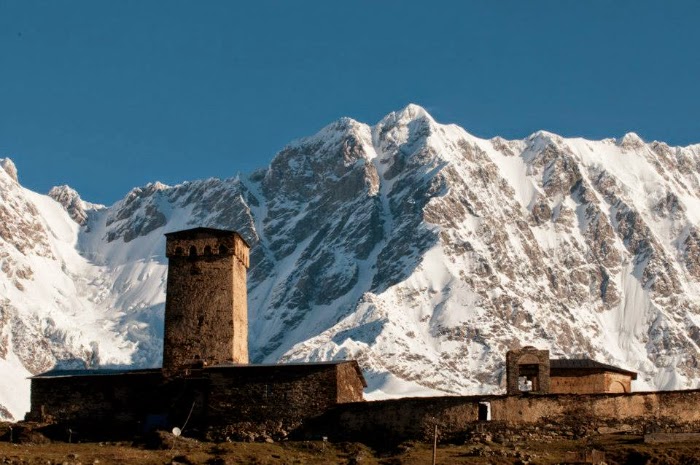Georgia
Georgia is a country in the Caucasus region of Eurasia. Located at the crossroads of Western Asia and Eastern Europe, it is bounded to the west by the Black Sea, to the north by Russia, to the south by Turkey and Armenia, and to the southeast by Azerbaijan. The capital of Georgia is Tbilisi. Georgia covers a territory of 69,700 square km and its population is almost 5 million.
Capital: Tbilisi
Major Language: Georgian
Major Religion: Christianity
Currency: Georgian Lari (GEL) 1$ = 1.75 GEL 1€ = 2.4 GEL
Internet Domain: .ge
International Dialing Code: +995
Tbilisi

Tbilisi formerly known as Tiflis, is the capital and the largest city of Georgia, lying on the banks of the Mtkvari River with a population of roughly 1.5 million inhabitants. Founded in the 5th century by the monarch of Georgia's ancient precursor Kingdom of Iberia, Tbilisi has served, with various intervals, as Georgia's capital for more than a thousand years.
Tbilisi has a number of important landmarks and sightseeing locations. The Parliament and the government (State Chancellery) buildings of Georgia, as well as the Supreme Court of Georgia, are all located in Tbilisi. The city also has important cultural landmarks such as the Georgian National Museum, Tbilisi State Conservatoire, Tbilisi Opera and Ballet Theatre, Shota Rustaveli State Academic Theatre, Marjanishvili State Academic Theatre, the Sameba Cathedral, the Vorontsov's Palace (also known as the Children's Palace today), many state museums, the National Public Library of the Parliament of Georgia, the National Bank of Georgia and other important institutions. During the Soviet times, Tbilisi continuously ranked in the top 4 cities in the Soviet Union for the number of museums.
Out of the city's historic landmarks, the most notable locations are the Narikala fortress (4th–17th century), Anchiskhati Church (6th century, built up in the 16th century), Sioni Cathedral (8th century, later rebuilt), Church of Metekhi (13th century), etc.
Climate
The climate of Georgia is extremely diverse, considering the nation's small size. There are two main climatic zones, roughly separating Eastern and Western parts of the country. The Greater Caucasus Mountain Range plays an important role in moderating Georgia's climate and protects the nation from the penetration of colder air masses from the north. The Lesser Caucasus Mountains partially protect the region from the influence of dry and hot air masses from the south as well.
Eastern Georgia has a transitional climate from humid subtropical to continental. The region's weather patterns are influenced both by dry Caspian air masses from the east and humid Black Sea air masses from the west. The penetration of humid air masses from the Black Sea is often blocked by several mountain ranges (Likhi and Meskheti) that separate the eastern and western parts of the nation. Annual precipitation is considerably less than that of western Georgia and ranges from 400–1,600 mm (15.7–63.0 in).Much of western Georgia lies within the northern periphery of the humid subtropical zone with annual precipitation ranging from 1,000–4,000 mm (39.4–157.5 in). The precipitation tends to be uniformly distributed throughout the year, although the rainfall can be particularly heavy during the Autumn months. The climate of the region varies significantly with elevation and while much of the lowland areas of western Georgia are relatively warm throughout the year, the foothills and mountainous areas (including both the Greater and Lesser Caucasus Mountains) experience cool, wet summers and snowy winters (snow cover often exceeds 2 meters in many regions). Ajaria is the wettest region of the Caucasus, where the Mt. Mtiralara inforest, east of Kobuleti receives around 4,500 mm (177.2 in) of precipitation per year.
The wettest periods generally occur during Spring and Autumn while Winter and the Summer months tend to be the driest. Much of eastern Georgia experiences hot summers (especially in the low-lying areas) and relatively cold winters. As in the western parts of the nation, elevation plays an important role in eastern Georgia where climatic conditions above 1,500 metres (4,921 ft) are considerably colder than in the low-lying areas. The regions that lie above 2,000 metres (6,562 ft) frequently experience frost even during the summer months.
You can see details about georgian climate on this LINK.
Georgian cuisine refers to the cooking styles and dishes with origins in the nation of Georgia and prepared by Georgian people around the world. The Georgian cuisine is specific to the country, but also contains some influences from other Middle Eastern and European culinary traditions, as well as those of the surrounding Western Asia. The cuisine offers a variety of dishes with various herbs and spices. Each historical province of Georgia has its own distinct culinary tradition, such as Megrelian, Kakhetian, and Imeretian cuisines. In addition to various meat dishes, Georgian cuisine also offers a variety of vegetarian meals.
 Georgian cuisine is the result of the rich interplay of culinary ideas carried along the trade routes by merchants and travelers alike. The importance of both food and drink to Georgian culture is best observed during a feast called supra, when a huge assortment of dishes is prepared, always accompanied by large amounts of wine, and that can last for hours. In a Georgian feast, the role of the tamada (toastmaster) is an important and honoured position.
Georgian cuisine is the result of the rich interplay of culinary ideas carried along the trade routes by merchants and travelers alike. The importance of both food and drink to Georgian culture is best observed during a feast called supra, when a huge assortment of dishes is prepared, always accompanied by large amounts of wine, and that can last for hours. In a Georgian feast, the role of the tamada (toastmaster) is an important and honoured position.







No comments:
Post a Comment